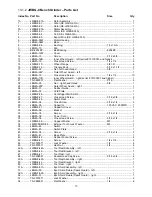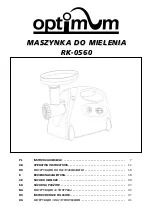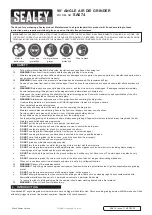
11
7.1
Grounding instructions
1. All Grounded, Cord-connected Tools:
In the event of a malfunction or breakdown,
grounding provides a path of least resistance for
electric current to reduce the risk of electric shock.
This tool is equipped with an electric cord having
an equipment-grounding conductor and a
grounding plug. The plug must be plugged into a
matching outlet that is properly installed and
grounded in accordance with all local codes and
ordinances.
Do not modify the plug provided – if it will not fit the
outlet, have the proper outlet installed by a
qualified electrician.
Improper connection of the equipment-grounding
conductor can result in a risk of electric shock. The
conductor with insulation having an outer surface
that is green with or without yellow stripes is the
equipment-grounding conductor. If repair or
replacement of the electric cord or plug is
necessary, do not connect the equipment-
grounding conductor to a live terminal.
Check with a qualified
electrician or service pe
r
sonnel if the
grounding instructions are not completely
understood, or if in doubt as to whether the
tool is properly grounded. Failure to comply
may cause serious or fatal injury.
Use only 3-wire extension cords that have 3-prong
grounding plugs and 3-pole receptacles that accept
the tool's plug.
Repair or replace damaged or worn cord
immediately.
2. Grounded, cord-connected tools intended for
use on a supply circuit having a nominal rating
less
than 150
volts:
This tool is intended for use on a circuit that has an
outlet that looks like the one illustrated in
A
, Figure
7. An adapter, shown in
B
, Figure 7, may be used
to connect this plug to a 2-pole receptacle if a
properly grounded outlet is not available. The
temporary adapter should be used only until a
properly grounded outlet can be installed by a
qualified electrician.
This adapter is not permitted
in Canada.
The green-colored rigid ear, lug, and
the like, extending from the adapter must be
connected to a permanent ground such as a
properly grounded outlet box.
7.2
Extension cords
USE PROPER EXTENSION CORD. Use only
three-wire extension cords that have three-prong
grounding type plugs and three-prong receptacles
that accept the tool's plug.
Make sure your extension cord is in good
condition. When using an extension cord, be sure
to use one heavy enough to carry the current your
product will draw. An undersized cord will cause a
drop in line voltage resulting in loss of power and
overheating. Table 1 shows correct size to use
depending on cord length and nameplate ampere
rating. If in doubt, use the next heavier gauge. The
smaller the gauge number, the heavier the cord.
Amp
Rating
Volts Total length of cord in feet
120
240
25
50
50
100
100
200
150
300
AWG
0 - 6
18
16
16
14
6 - 10
18
16
14
12
10 - 12
16
16
14
12
12 - 16
14
12
Not
Recommended
Table 1: extension cord recommendations
8.0
Adjustments
Disconnect saw from power
source before making adjustments.
8.1
Eye shield tilt adjustment
1. Loosen lock knob (B, Figure 8).
2. Adjust eye shield (T) to desired tilt angle.
3. Tighten lock knob (B).
8.2
Spark guards
As the wheel wears down, the spark guards must
be readjusted to maintain 1/16" distance from the
wheel.
To adjust:
1. Loosen two hex cap screws (L, Figure 8) with
a 10mm wrench.
2. Slide the spark guard to 1/16" distance from
grinding wheel surface.
3. Tighten screws (L).
Figure 8: eye shield and tool rest adjustment






































